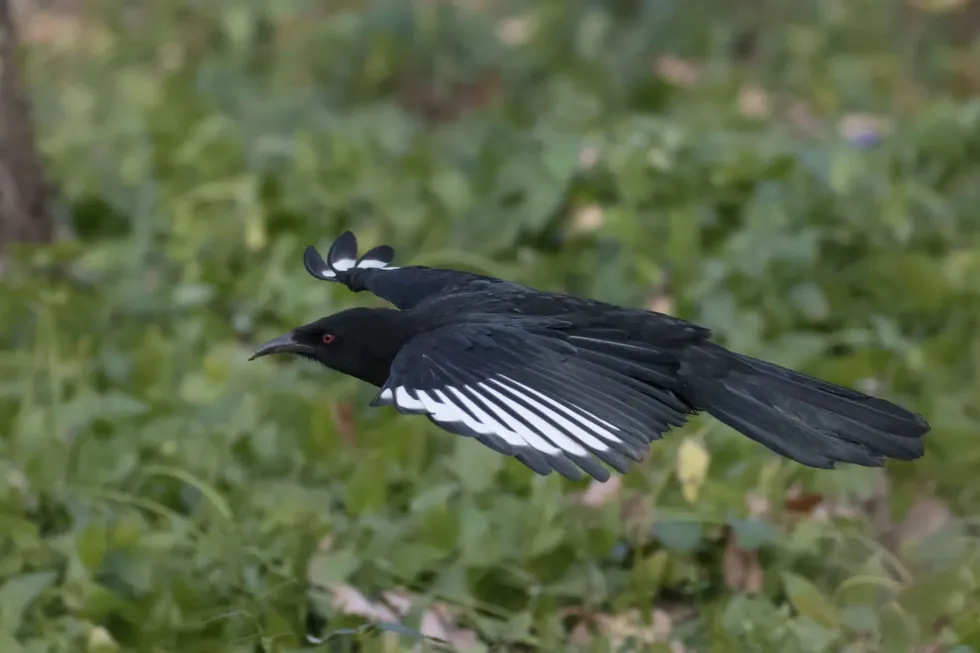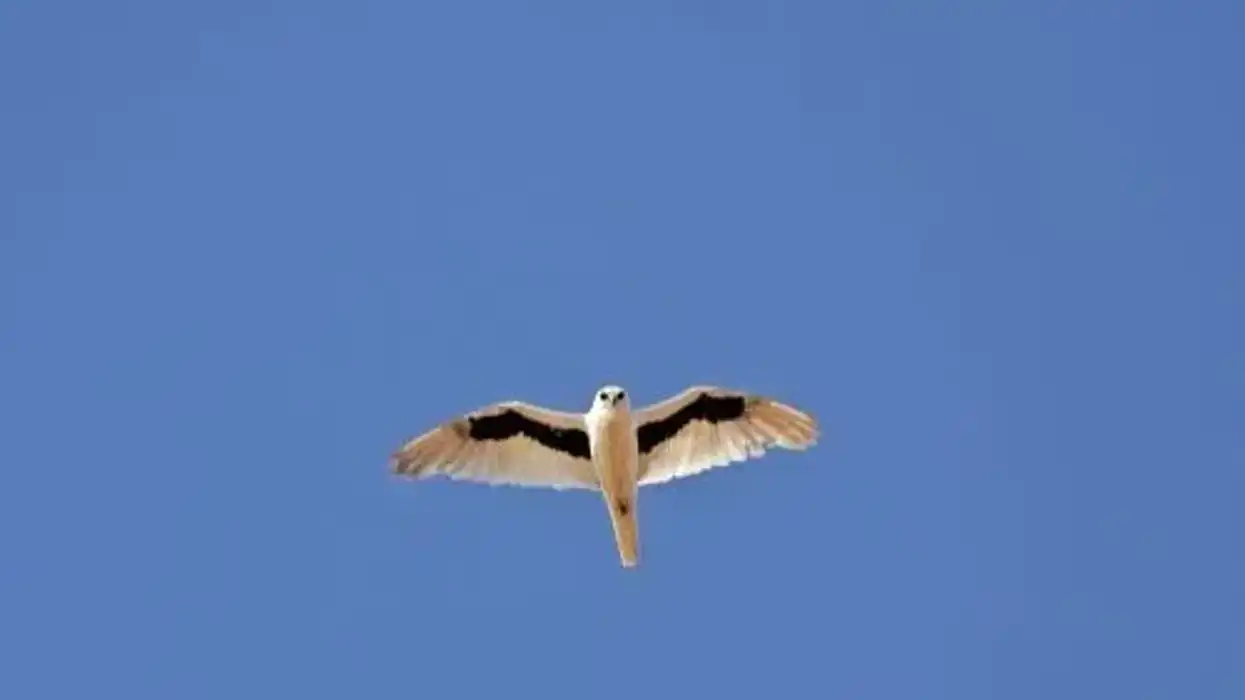The white-winged chough is deemed to be one of the members of the Australian mudnester or the Corcoracidae family. The family Corcoracidae primarily consists of two species.
These are the Apostle bird and the other is the white-winged chough. These species are the inhabitants of open woodlands or forests and is considered a native Australian species.
As a result of convergent evolution, the white-winged chough is distantly linked to the other choughs of Europe. Frequently confused with crows, the white-winged chough is distinguished for its red eye and white wing patches.
Their bill is also curved. Louis Pierre Vieillot, a French naturalist, was the first person who described the white-winged chough (Corcorax melanorhamphos) as Coracia melanorhamphos in 1817.
Later in 1820, a Dutch zoologist named Coenraad Jacob Temminck named it Pyrrhocorax leucopterus. It was renamed once again in 1830 by René Primevère Lesson, who happened to be another French naturalist.
René named the bird Corcorax australis. Finally, it was named in 1912 by Gregory Mathews which was derived from two ancient Greek words ‘melano’ and ‘rhamphos’, meaning ‘ black’ and ‘beak’ respectively.
Do you wish to learn more about the white-winged chough? Leep reading this article as more fascinating facts are stated below. If you like this article, then make sure to check our other articles on Alpine chough and flameback woodpecker.
White-Winged Chough Interesting Facts
What type of animal is a white-winged chough?
The white-winged chough (Corcorax melanorhamphos) is an Australian bird species identified for its unique feather pattern and red eyes.
What class of animal does a white-winged chough belong to?
The white-winged chough belongs to the class of Aves, order Passeriformes, family Corcoracidae and genus Corcorax. This species is further branched into two subspecies. These subspecies are the Corcorax melanorhamphos melanorhamphos and Corcorax melanorhamphos whiteae.
How many white-winged choughs are there in the world?
The white-winged chough is present abundantly, however, its subspecies Corcorax melanorhamphos whiteae can be hard to detect. The population of white-winged choughs is not under any threat but the total number of birds present in the world is not yet estimated.
Where does a white-winged chough live?
The white-winged chough distribution range is within the Australian continent, particularly in the eastern region.
What is a white-winged chough's habitat?
The habitat of the white-winged chough (Corcorax melanorhamphos) is predominantly open woodlands or forests. Eucalyptus and pine woodlands are the ideal habitats for these birds because they prefer an open canopy.
Other than forests, these birds can be located in suburban areas. The particular vegetation that white-winged choughs like is scarce shrubs, abundant leaf litter, fallen barks, and twigs. The nest is built by both male and female birds and it is made up of layers of mud and grasses.
Who do white-winged choughs live with?
White-winged choughs are extremely social birds and live in large groups or flocks. These flocks consist of as many as 18 helpers that assist the breeding pair during the breeding season by brooding and feeding the young birds.
How long does a white-winged chough live?
The average lifespan of the white-winged chough is 16 years.
How do they reproduce?
The white-winged chough attains their sexual maturity by the time they become four years old. Their body undergoes a lot of changes meanwhile.
The breeding season of this bird ranges between September to December. However, these birds tend to breed after rainfall in comparatively arid areas.
The system of breeding among the white-winged chough is unique as the group consists of one breeding pair and many helpers. This means the breeding and nesting are collective and comprise approximately 18 helpers in one group.
The nest is constructed by the combined efforts of all the group members. The nest is primarily a large mud bowl that is constructed 26.2-32.8 ft (8-10 m) above the ground.
The main breeding pair copulate and the average clutch size is three to five eggs. The eggs are cream-colored with lavender and dark brown blotches.
The incubation period is roughly 19-20 days. After the eggs are hatched, the young birds are fed and brooded by all the other family members or helpers.
The duration of nestling is almost 30 days, however, the young birds are not independent until they are six to seven months. It has been observed that breeding pairs with large family groups are more successful in giving birth and raising young birds than small groups.
What is their conservation status?
The conservation status of the white-winged chough according to the International Union for the Conservation of Nature is of Least Concern. These birds are not common because they are sparsely allocated.
White-Winged Chough Fun Facts
What do white-winged choughs look like?
The family Corcoracidae consists of two species out of which the Aposltebird is relatively smaller than the white-winged chough, which happens to be a large black bird. This species is approximately 17.3-19.6 in (44–50 cm) in length and weighs around 9.8-14.9 oz (277–422 g).
This species is not sexually dimorphic because the male and female birds are similar. This is one of the species of Australian mudnester and so their ontogeny is like that of birds which feed on the ground.
The plumage of this bird is glossy black and has white wing patches. The most incredible characteristics of this bird are its white patches on the wings that look extraordinary when it flies.
The structure of the bill of the bird reflects their feeding ecology. The white-winged chough has a curved bill that is long and slender.
These birds with the help of their bill like to flick leaf litter. The white-winged chough has red-eye and long legs.

How cute are they?
The white-winged chough looks magnificent when it flies because of the white patches. Upon folding it's wings, it is frequently confused with a crow or a raven and people may not find them cute.
How do they communicate?
The white-winged chough call is distinct because it is ventriloquial and low-pitched.
How big is a white-winged chough?
The white-winged chough is approximately 17.3-19.6 in (44–50 cm) in length. These birds are smaller than the common raven which is 22-30.7 in (55.8-77.9 cm) in length.
How fast can a white-winged chough fly?
The speed of the white-winged chough is not listed.
How much does a white-winged chough weigh?
The white-winged chough is a large bird and weighs approximately 9.8-14.9 oz (277–422 g).
What are the male and female names of the species?
Some bird species have specialized names however no such names have been given to male and female white-winged choughs.
What would you call a baby white-winged chough?
The newly hatched babies are called hatchlings, however, there is no specific name given to baby white-winged choughs. The major threat to hatchlings is currawongs.
What do they eat?
White-winged choughs are omnivores and their diet consists of various berries, grasses, insects like termites and beetles. These birds scrape the leaf litter to search for prey. They also eat grasshoppers, cockroaches, wasps, bees, ants, cricket, moth, butterflies, and other invertebrates.
Are they dangerous?
There is no such incident that has been documented about them being dangerous to humans.
Would they make a good pet?
White-winged choughs should not be kept as a pet because they do not do well in captivity. These are social birds that prefer living in flocks therefore it is better not to confine them.
Did you know...
The eye color of the white-winged chough initially alters from brown to orange and finally becomes red when they attain sexual maturity. Their plumage also changes to a darker color.
The kidnapping of young birds from another group by choughs is a common practice.
How many types of white-winged chough are there?
The white-winged chough is a native Australian bird. Due to its resemblance with crows and ravens, it is often confused with them. However, the white-winged chough mainly has two subspecies.
These are the Corcorax melanorhamphos melanorhamphos and Corcorax melanorhamphos whiteae. The Corcorax melanorhamphos melanorhamphos is distributed across the east of Australia from Queensland to New South Wales. This bird can also be spotted in Victoria and South Australia.
The Corcorax melanorhamphos whiteae is distinguished for its modified bill which is short and thin. This subspecies is not as large as the other chough birds. They have pink wing patches instead of white wing patches. The Corcorax melanorhamphos whiteae is extremely hard to spot and its distribution range is limited within south and southeastern areas of South Australia.
The white-winged chough's wings
The incredible feature of the white-winged chough’s wings is that when their wings are folded, they appear completely black. However, there are white wing patches that remain hidden when folded but when they fly or flap their wings, the white wing patches look amazing.
This is why these birds are called white-winged choughs. One of its subspecies Corcorax melanorhamphos whiteae may have pinkish wing patches rather than white ones
Here at Kidadl, we have carefully created lots of interesting family-friendly animal facts for everyone to discover! For more relatable content, check out these black woodpecker facts and gyrfalcon facts pages.
You can even occupy yourself at home by coloring in one of our free printable white-whinged chough coloring pages.
Second image by Benjamint444.










